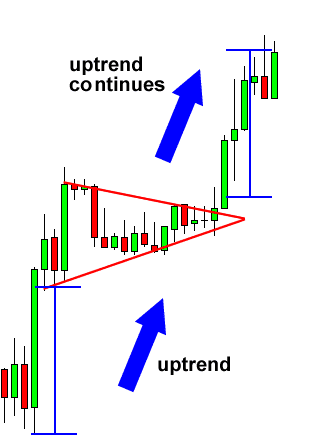Forex trading strategies for using the Bullish Pennant pattern: Techniques for trading with the Bullish Pennant chart pattern.
In the dynamic world of forex trading, successful traders rely on a diverse set of tools and strategies to navigate the complexities of the market. Among these tools, chart patterns play a crucial role in providing insights into potential price movements. One such pattern that traders keenly observe is the Bullish Pennant pattern. This article delves into the techniques and strategies for effectively trading with the Bullish Pennant chart pattern.
Table Content
I. Understanding the Bullish Pennant Pattern
II. Trading Techniques for the Bullish Pennant Pattern
1. Confirming the Pattern
2. Entry Points
3. Stop Loss and Take Profit
4. Confirmation Indicators
5. Multiple Timeframes
6. News and Events
7. Practice Patience
8. Combine with Other Strategies
9. Demo Trading
10. Continuous Learning
III. Footnote
Understanding the Bullish Pennant Pattern
Before delving into trading strategies, it's essential to comprehend what the Bullish Pennant pattern is and how it forms. The Bullish Pennant is a continuation pattern that typically emerges during strong uptrends. It signifies a brief consolidation period before the prevailing uptrend resumes. Visually, the pattern resembles a small symmetrical triangle, often referred to as the "pennant," that is preceded by a sharp price move, or the "flagpole."

The Bullish Pennant pattern consists of the following elements:
- Flagpole: This is the initial strong upward move in price, representing the first phase of the pattern. It is marked by high trading volumes and sets the stage for the pennant formation.
- Pennant: The flagpole is followed by a period of consolidation where the price forms converging trendlines, creating a triangle-like shape. During this phase, trading volumes usually decrease.
- Breakout: The Bullish Pennant pattern concludes with a breakout to the upside, where the price resumes its upward movement. The breakout is typically accompanied by an increase in trading volume.
Trading Techniques for the Bullish Pennant Pattern
Trading the Bullish Pennant pattern requires a combination of technical analysis, risk management, and market awareness. Here are some strategies that traders can employ to effectively utilize this pattern:
1. Confirming the Pattern: As with any trading strategy, confirmation is crucial. Traders should patiently wait for the pennant to form after the flagpole. The converging trendlines of the pennant should be clearly visible, indicating a decrease in volatility. Additionally, confirming the pattern requires observing a noticeable decline in trading volume during the pennant formation.
2. Entry Points: The optimal entry point for a Bullish Pennant trade is after the breakout. Wait for the price to break above the upper trendline of the pennant on a candlestick chart. This breakout should ideally be accompanied by a surge in trading volume, validating the potential for a strong upward movement.
3. Stop Loss and Take Profit: Implementing effective risk management is a fundamental aspect of trading. Place a stop-loss order just below the lower trendline of the pennant to protect your capital in case the breakout fails. When setting take-profit levels, consider measuring the flagpole's height and projecting it upwards from the point of breakout. This can provide an estimation of the potential price movement.
4. Confirmation Indicators: To bolster your trading decisions, consider using technical indicators. Moving averages, such as the 50-period and 200-period moving averages, can help confirm the prevailing trend's strength. Additionally, oscillators like the Relative Strength Index (RSI) can indicate whether the market is overbought or oversold, providing insight into potential reversals.
5. Multiple Timeframes: Analyzing the Bullish Pennant pattern across multiple timeframes can provide a comprehensive view of the market's behavior. A pattern that appears strong on both shorter and longer timeframes increases the probability of a successful trade.
6. News and Events: While technical analysis is crucial, it's essential to stay aware of significant news and economic events that might impact the market. Positive news or events related to the currency pair in question can further support the bullish bias of the Bullish Pennant pattern.
7. Practice Patience: Patience is a virtue in forex trading. It's important to wait for the pattern to fully develop and confirm before executing a trade. Impulsive decisions can lead to losses.
8. Combine with Other Strategies: The Bullish Pennant pattern can be even more potent when used in conjunction with other trading strategies. For instance, combining it with trendline analysis or candlestick patterns can offer additional confirmation.
9. Demo Trading: Before applying the Bullish Pennant pattern in live trading, consider practicing on a demo account. This allows you to refine your strategy, test different parameters, and gain confidence in your trading decisions without risking real capital.
10. Continuous Learning: The forex market is ever-evolving. Stay committed to continuous learning by staying updated on market trends, attending webinars, reading relevant books, and following reputable financial news sources.
Footnote
The Bullish Pennant pattern is a valuable tool in a forex trader's arsenal. It provides insights into potential price continuation and can lead to profitable trades if approached with the right strategies. However, like any trading strategy, it's not foolproof, and risks are inherent in forex trading. Therefore, it's essential to combine technical analysis with effective risk management and a deep understanding of market dynamics. By patiently waiting for confirmations, identifying optimal entry and exit points, and staying informed about market events, traders can harness the power of the Bullish Pennant pattern to enhance their trading success. Remember, practice and discipline are key to mastering this, or any, trading strategy.











Discussion